The AMD Radeon VII Review: An Unexpected Shot At The High-End
by Nate Oh on February 7, 2019 9:00 AM ESTProfessional Visualization and Rendering
With AMD strongly pushing the Radeon VII as a prosumer content creation card, it behooves us to look at rendering, CAD, and professional visualization performance. However, accurate and applicable benchmarks for this field are not so easy to find, especially since performance is highly dependent on workflow and proprietary licensed ISV software. Given AnandTech’s audience, which often includes engineers using these applications in critical production environments, our goal is to provide the most relevant metrics. However, as Ian has discussed previously, the route to the most accurate workstation benchmarking for professional applications is in the hands of ISVs, who are at best blasé and more typically negative about providing access, even at the prospect of lending limited software licenses in return for ongoing discussion and third-party benchmark data of their software.
Those caveats in mind, the next best thing for evaluating overall GPU workstation performance is the venerable SPECviewperf, recently updated to version 13. Separated into ‘viewsets,’ which are a group of application-specific workloads derived from real-world datasets, SPECviewperf has been a longstanding suite for generalized workstation/CAD GPU performance. For SPECviewperf 13, the viewsets are based on:
- Autodesk 3ds Max 2016 (Nitrous DX11 driver)
- Dassault Systèmes CATIA V6 R2012
- PTC Creo 3 & Creo 4
- Geosurvey software, with workloads based on rendering techniques utilized by the open-source OpendTect seismic visualization application
- Autodesk Maya 2017
- Radiological (i.e. CT, MRI scans) rendering, with workloads using the Tuvok rendering core of the ImageVis3D volume visualization application
- Autodesk Showcase 2013
- Siemens NX 8.0
- Dassault Systèmes Solidworks 2013 SP1
While we didn’t have time for complete benchmarking of video editing/production software such as Adobe Premiere Pro CC, we will be looking to include that in the future.
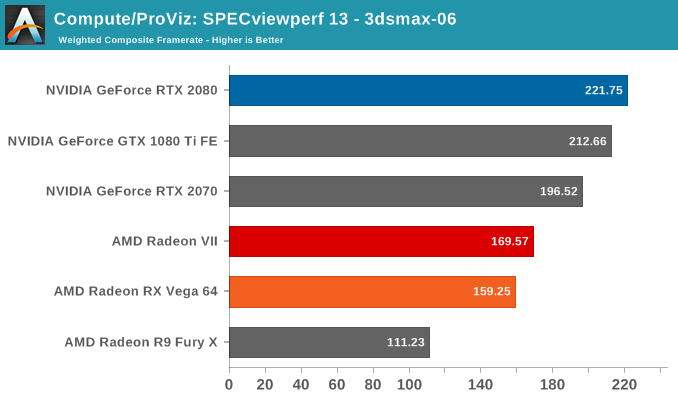
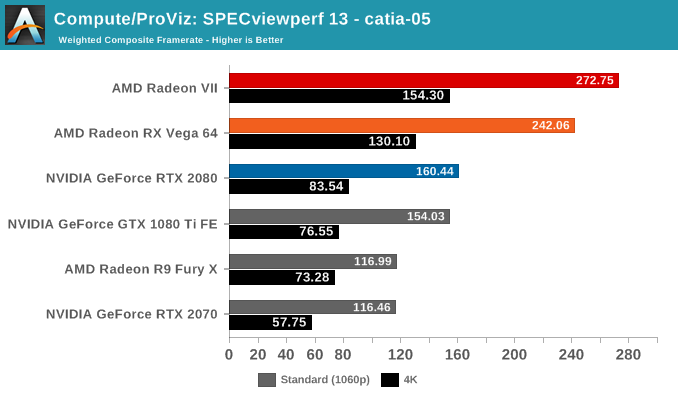

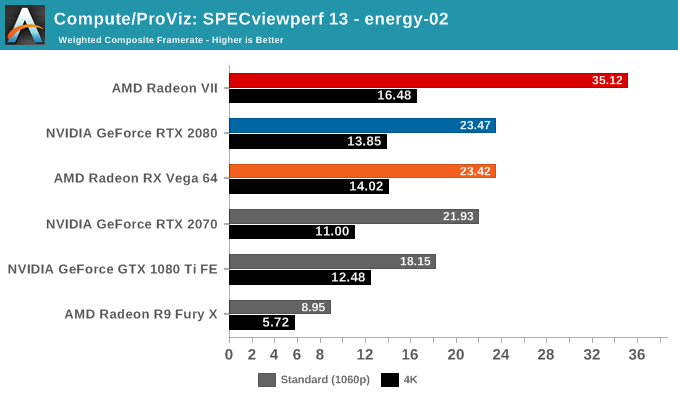
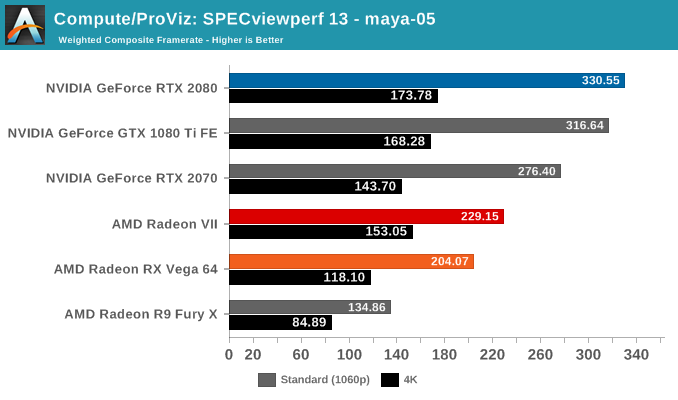
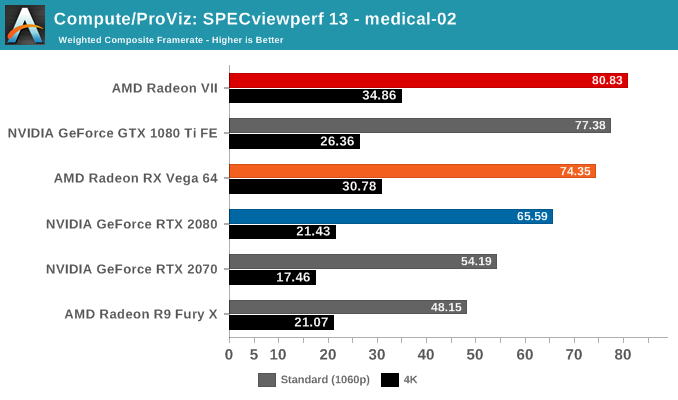
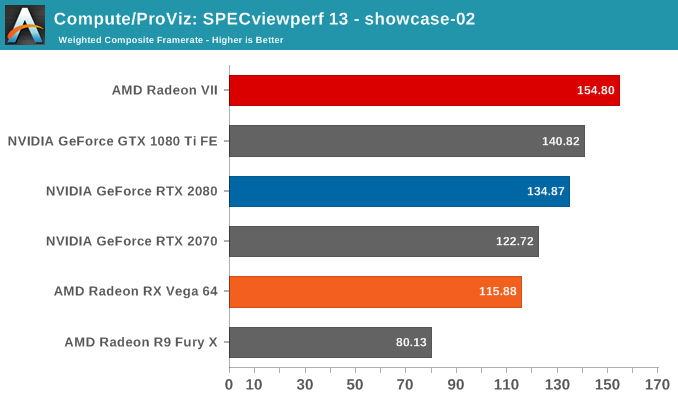
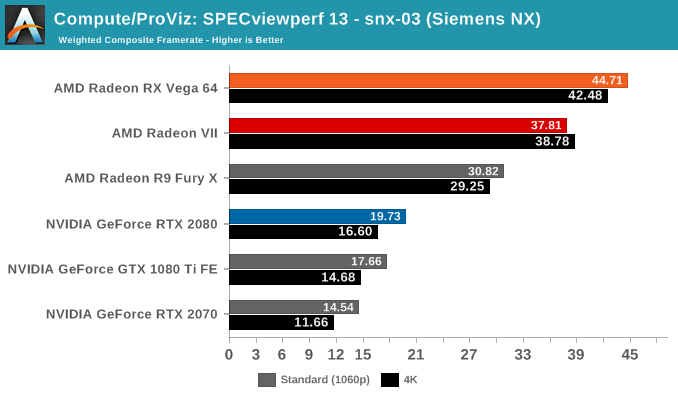
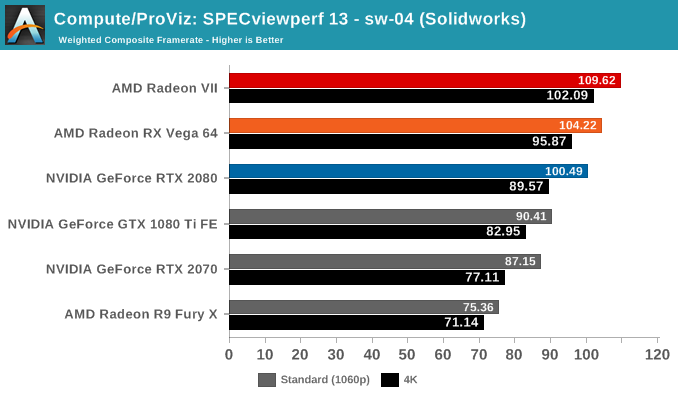
Looking over the results, it's clear that certain viewsets tend to perform better on one vendor's hardware than the other's. In those cases, the Radeon VII doesn't buck the trend, though in Siemens NX the lower performance is more likely than not related to driver maturity. In the reverse scenarios like in creo-02 or maya-05, the Radeon VII is in a similar spot, naturally ahead of the RX Vega 64 but behind the competing RTX and GTX cards. If anything, the results highlight the importance of software maturity for newer hardware, but there are definite signs of Vega 20 being a powerful workstation card. The caveat is that it doesn't seem to change the overall landscape for worksets that traditionally perform well on NVIDIA hardware.
Our next set of benchmarks look at rendering performance. To be clear, given the nature of ‘render wars’ as well as the adoption of CUDA, the featured render engines are not necessarily indicative of the overall GPU renderer landscape. Because we are looking at the Radeon VII, it’s not applicable to include some of the more popular renderers, such as Redshift and Octane, which are CUDA-only, and similarly the presence of Indigo Renderer helps as another datapoint even though it is less popular.


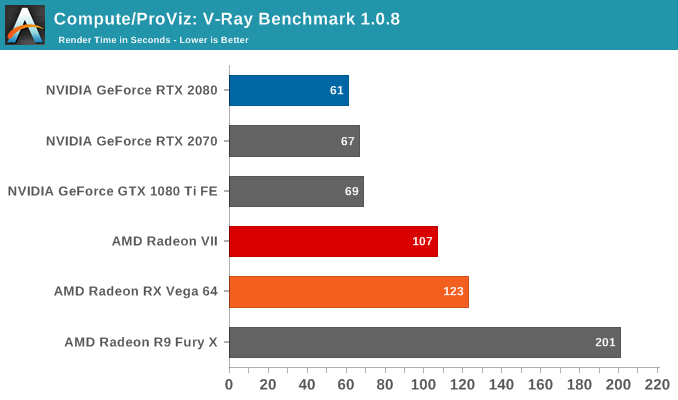

To note, official Blender releases have yet to incorporate CUDA 10, and so RTX 20 series cards are not officially supported.
V-RAY here is the only test that utilizes CUDA for NVIDIA cards, while the rest all use OpenCL. The results seem broadly similar to SPECviewperf, where the Radeon VII continues to excel at workloads where AMD hardware generally fare well.










289 Comments
View All Comments
Manch - Monday, February 11, 2019 - link
My bad on Wolf. I thought it was. It's on XB1 which is DX12 and DX12 supt was confirmed by a few places so I didn't check further.As for Vulkan Games, off the top of my head(whats in my library), TWS:ToB, TW: Warhammer II (should have been in my table..oops), Warhamer 40K DoW III, Serious SAM VR games, x-plane. I'm sure there are others. Easy to look up.
IMO FPS should not be the definitive test for all API's. Variety is always nice.
Cherry pick my mistakes but my point stands. I get the test bed needs to be locked down so consistent results can be achieved. Anandtech needs to be able to give specific measurable and repeatable results and they do that. I'm just merely expressed my desire to see a more balanced test suite in regards to APIs & games that are design for NVidia or AMD GPU's.
eddman - Tuesday, February 12, 2019 - link
Are you basing that on personal experience or simply getting the info from vulkan's wikipedia page, without checking the platform column?TWS:ToB, TW: Warhammer II and Warhamer 40K DoW III use vulkan only on linux.
Despite the vulkan addition, Serious sam games are old, non-demanding and not suitable for benchmarking.
X-plane does not support vulkan yet; it's a work-in-progress. Still, even if it does add it eventually, it too is not suitable for benchmarking.
Ryan Smith - Thursday, February 7, 2019 - link
The benchmark suite gets updated on a roughly yearly basis. It was last updated for the Turing launch, so we're only about 5 months into it. As part of ensuring we cover a reasonable selection of genres, these were the best games available in the fall of 2018.The next time we update it will presumably be for AMD's Navi launch, assuming that still happens in 2019. Though it's never too early to suggest what games you'd like to see.
eva02langley - Thursday, February 7, 2019 - link
Devil May Cry, Resident Evil, Anthem, metro Exodus, The Division 2, Rage 2, Mortal Kombat 11krazyfrog - Sunday, February 10, 2019 - link
Half-Life 3SeannyB - Thursday, February 7, 2019 - link
I would like to see a title from each of the general purpose engines, namely UE4 and Unity.Korguz - Thursday, February 7, 2019 - link
maybe i am the only one here.. but the games AT tests... i dont play ANY of them :-)Ryan Smith - Thursday, February 7, 2019 - link
Out of curiosity, what do you play?Korguz - Friday, February 8, 2019 - link
WOW, Starcraft 2 Diablo 3 and some older games... games that dont really " need " a card like this.. my current asus strix 1060, plays these just fine at almost max eye candy... the only game i can think of that i have, and play that might need this card.. is Supreme commander, but im not sure if that game needs a strong cpu, or gpu, maybe a bit of both...Holliday75 - Friday, February 8, 2019 - link
Love me some Supreme Commander. Solid followup to Total Annihilation. As to its performance I think its more CPU based and quite frankly the engine is not optimized for modern hardware.